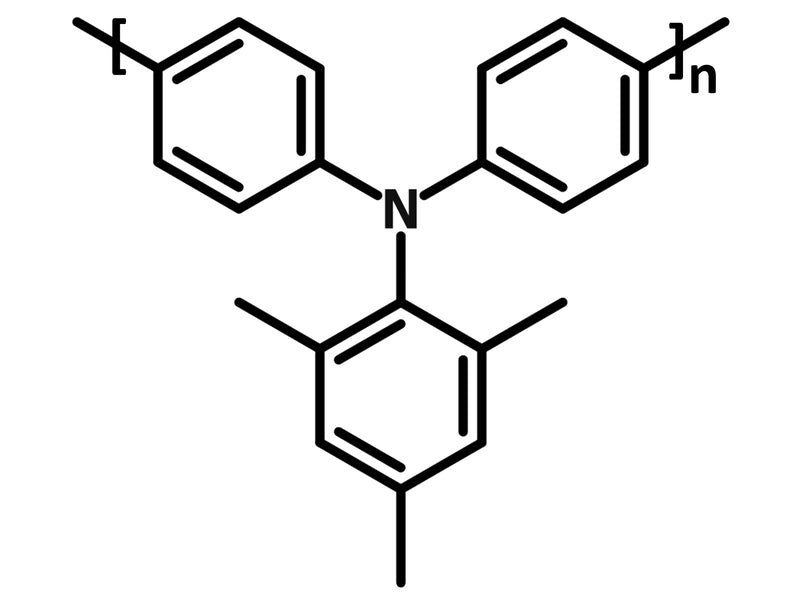PTAA for Perovskite Applications
CAS Number 1333317-99-9
Charge Transport Layer Materials, Hole Transport Layer Materials, Interface Polymers, Materials, Perovskite Interface Materials, Perovskite Materials,PTAA, to substantially improve PCE of perovskite solar cells
High quality HTL and EBL semiconducting material
Overview | Specifications | MSDS | Pricing and Options | Literature and Reviews
Poly[bis(4-phenyl)(2,4,6-trimethylphenyl)amine (PTAA), CAS number 1333317-99-9, one of the family members of poly(triaryl)amine, is an excellent hole-transporting and electron-blocking semiconducting material due to its electron-rich components. It is a popular choice for perovskite solar cell devices, due to its:
- Easy processibility
- Good hole transport and electron blocking qualities
- High thermal stability
- Use in both regular and inverted devices
PTAA from Ossila was used in the high-impact paper (IF 30.85), Multiply Charged Conjugated Polyelectrolytes as a Multifunctional Interlayer for Efficient and Scalable Perovskite Solar Cells, E. Jung et al., Adv. Mater., 2002333 (2020); DOI: 10.1002/adma.202002333.
Semiconducting material
High quality HTL and EBL semiconducting material
Improve open circuit voltage
(Voc) and fill factor (FF)
High Quality
High quality & Electron Rich
Hole-transport layer
improved device performance
General Information
| CAS number | 1333317-99-9 |
| Chemical formula | (C21H19N)n |
| Molecular weight | Please see batch details |
| HOMO / LUMO | HOMO 5.25 eV LUMO 2.30 eV [6] |
| Soluble in | THF, toluene, chloroform, chlorobenzene, dichlorobenzene |
| Recommended Processing Solvents at 10mg/ml | THF (8mg/ml) |
| Synonyms |
|
| Classification / Family | Polyamines, Hole-transport layer materials, Electron-blocking layer materials, Organic semiconducting materials, Organic photovoltaics, Polymer solar cells, OLED materials |
Chemical Structure

Notable Device Performances using PTAA
| JSC | VOC | FF | PCE | Ref |
| 16.5 mA/cm2 | 0.997 V | 72.7% | 12.0% | (Heo et al., 2013) |
| 21.84 mA/cm2 | 1.114 | 73.6% | 17.91% | (Jeon et al., 2015) |
| 24.7 mA/cm2 | 1.06 | 77.5% | 20.2% | (Yang et al., 2015) |
| 25.7 mA/cm2 | 1.118 | 82.3% | 25.0% | (Li et al., 2022) |
MSDS Documentation
Pricing
| Batch | Quantity | Price |
| M0511A9/A12/A13 | 100 mg | £250 |
| M0511A9/A12/A13 | 250 mg | £500 |
| M0511A9 | 500 mg | £900 |
| M0511A9 | 1 g | £1500 |
| M0511A12/A13 | 500 mg | £950 |
| M0511A12/A13 | 1 g | £1800 |
Free worldwide shipping on qualifying orders.
Batch details
| Batch* | Mw | Mn | PDI | Stock info |
| M0511A5 | 25,000 | 12,500 | 2.0 |
Discontinued |
| M0511A6 | 13,000 | 8,667 | 1.5 | Discontinued |
| M0511A7 | 30 kDa | 12.5 kDa | 2.4 | Discontinued |
| M0511A8 | 56 kDa | 19.5 kDa | 2.87 | Discontinued |
| M0511A9 | 11 kDa | 6.9 kDa | 1.60 | In Stock |
| M0511A12 | 30 kDa | 15.7 kDa | 1.91 | Low stock |
| M0511A13 | 27 kDa | 18 kDa | 1.50 | In Stock |
*Older batch information available on request.
Literature and Reviews
- Efficient inorganic–organic hybrid heterojunction solar cells containing perovskite compound and polymeric hole conductors, J. Heo et al., Nat. Photonics 7, 486–491 (2013) doi:10.1038/nphoton.2013.80.
- Compositional engineering of perovskite materials for high-performance solar cells, N. Jeon et al., Nature 517, 476–480 (2015), doi:10.1038/nature14133.
- High-performance photovoltaic perovskite layers fabricated through intramolecular exchange, W-S. Yang et al., Science, 348 (6240), 1234-1237 (2015). DOI: 10.1126/science.aaa9272.

 PTAA (Perovskite) MSDS sheet
PTAA (Perovskite) MSDS sheet